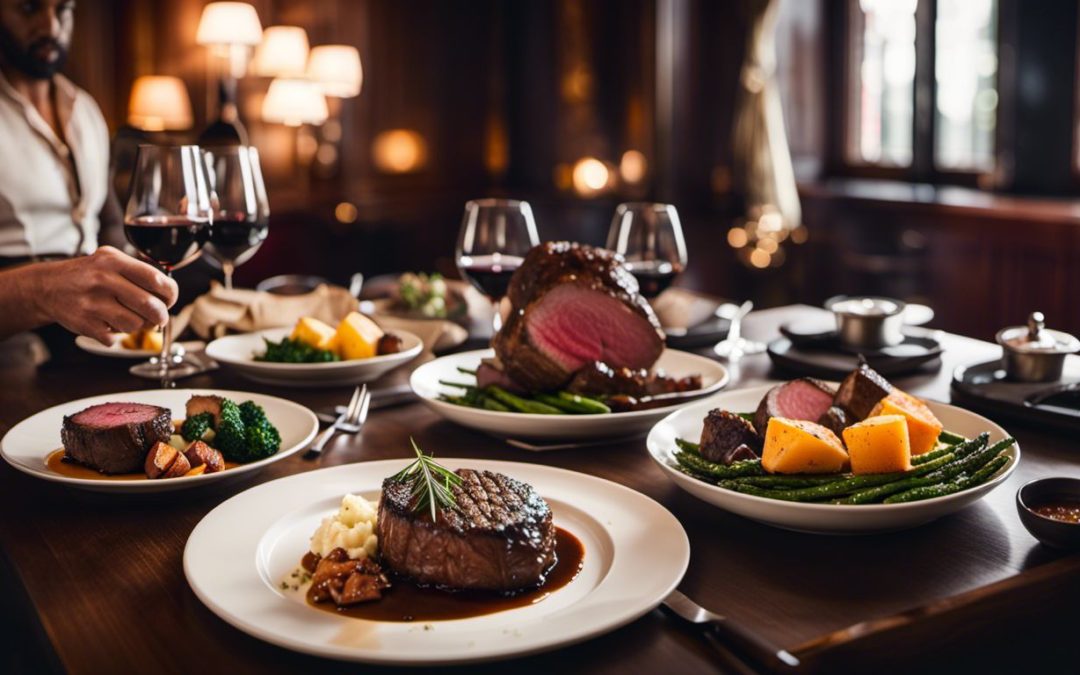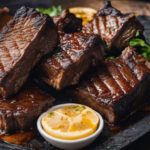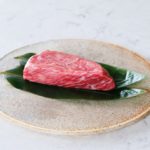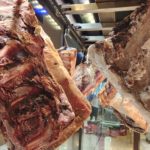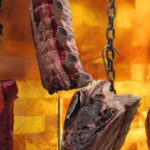Ever been in a steakhouse and felt confused over whether to order the chateaubriand or filet mignon? You’re not alone. Both are prime cuts of beef but, did you know they come from the same part of the cow – the tenderloin? This article is your ultimate guide to distinguish between chateaubriand and filet mignon, helping you make an informed choice next time you dine out.
So, let’s get up close and personal with these two culinary delights!
Key Takeaways
- Chateaubriand and filet mignon are both cuts of beef tenderloin, but they have differences in presentation, origin, flavor, and cooking methods.
- Chateaubriand is a fancy cut served as a roast for two or more people, while filet mignon is individually portioned and cooked as a single steak.
- Chateaubriand has a rich, buttery flavor with a slightly firmer bite, while filet mignon is incredibly tender with a delicate texture.
- Both cuts can be grilled or pan – seared to perfection and pair well with sides like mashed potatoes and steamed asparagus.
Understanding Chateaubriand and Filet Mignon
Chateaubriand and filet mignon are both cuts of beef tenderloin, but their differences in presentation, origin, flavor, and cooking methods make them distinct choices for meat lovers.
Cut and presentation
Chateaubriand is a fancy cut, usually taken from the center part of the tenderloin. It’s on the thicker side and served as a roast, ideal for two or more people sharing a meal. On the contrary, filet mignon gets its name from being dainty (“mignon” translates to cute or dainty in French).
Cut into thinner slices and cooked individually, these steaks are perfect for personal servings at dinner parties. For presentation purposes, Chateaubriand often comes with sauces like béarnaise or peppercorn sauce adding to its elegance, while filet mignon might be served plain or with minimal seasoning to highlight its natural taste and tenderness.
Origin and history
filet mignon and chateaubriand both have interesting origins and histories. These cuts of beef come from the tenderloin, which is a muscle located in the lower part of the cow. Chateaubriand is traditionally a thicker cut that comes from the center portion of the tenderloin, while filet mignon can be cut from various parts.
The name “chateaubriand” actually refers to both the dish and a French author who was known for his love of food. Filet mignon, on the other hand, has its roots in French cuisine as well, with “mignon” meaning “cute” or “dainty.” Both cuts have become popular choices for meat lovers around the world due to their tenderness and lean qualities.
Flavor and texture
Chateaubriand and filet mignon may come from the same part of the animal, but they have distinct differences in flavor and texture. Chateaubriand is known for its rich, buttery flavor and tender, melt-in-your-mouth texture.
It has a slightly firmer bite compared to filet mignon, which is incredibly tender with a delicate, velvety texture. Whether you prefer the robustness of chateaubriand or the silky smoothness of filet mignon, both cuts are sure to satisfy any meat lover’s cravings.

Differences Between Chateaubriand and Filet Mignon
Chateaubriand and Filet Mignon differ in their cooking methods and techniques, as well as their price.
Cooking methods and techniques
Cooking is a breeze, especially for meat lovers looking to enjoy the tender and flavorful qualities of these cuts. Here are some cooking methods and techniques to enhance your culinary experience:
- Grilling: Fire up the grill to cook both Chateaubriand and filet mignon to perfection. The high heat will sear the outside, locking in the juices and creating a beautiful char.
- Pan-searing: Heat up a skillet with some oil or butter and sear both sides of the steak until golden brown. This method creates a delicious crust while keeping the center juicy.
- Oven-roasting: Preheat your oven, season the steaks with your favorite spices, and roast them at a high temperature. This technique ensures even cooking and a tender result.
Price
Chateaubriand and filet mignon may have some differences in price. Due to its larger size, chateaubriand tends to be more expensive than filet mignon. Since it is meant to serve two or more people, it usually comes with a higher price tag.
On the other hand, filet mignon is individually portioned and generally costs less since you are only paying for one steak. However, keep in mind that prices can vary depending on factors such as the quality of the meat and where you purchase it from.
Ultimately, when deciding between chateaubriand and filet mignon, consider your budget and how many people you need to feed.
Similarities Between Chateaubriand and Filet Mignon
Both Chateaubriand and Filet Mignon are cuts of beef tenderloin that can be served individually portioned or as a roast.
Meat cut
Chateaubriand and filet mignon are both cuts of beef that come from the tenderloin. Chateaubriand is typically a larger cut meant to serve two or more people, while filet mignon is individually portioned.
Chateaubriand is often presented as a roast and cooked as a whole piece before being cut into portions, while filet mignon is usually cooked as a single steak. Chateaubriand comes from the center portion of the tenderloin and tends to be thicker than filet mignon.
Both cuts are known for their tenderness and lean qualities.
Pairings and serving suggestions
Pair your chateaubriand or filet mignon with these delicious sides and accompaniments to enhance your dining experience:
- Creamy mashed potatoes
- Steamed asparagus
- Roasted Brussels sprouts
- Sauteed mushrooms
- Cabernet Sauvignon or Malbec wine
- Horseradish cream sauce
- Grilled corn on the cob
- Baked sweet potato fries
- Caesar salad with homemade dressing
Best Cooking Methods for Chateaubriand and Filet Mignon
Grill or pan-sear the Chateaubriand and Filet Mignon for a smoky and caramelized flavor.
Grilling
Grilling is a fantastic way to prepare both chateaubriand and filet mignon. The high heat of the grill helps to sear the outside, while keeping the inside tender and juicy. Whether you prefer your steak rare, medium, or well-done, grilling allows you to achieve that perfect level of doneness.
Plus, the smoky flavor from the grill adds an extra layer of deliciousness to these already mouthwatering cuts of beef. So fire up the grill and get ready for a sizzling and satisfying meal!
Pan-searing
Pan-searing is a fantastic cooking method for both chateaubriand and filet mignon. It involves searing the meat in a hot pan with some oil, creating a delicious crust on the outside while keeping the inside tender and juicy.
This method locks in the flavors and enhances the natural juiciness of these cuts. Whether you prefer your steak rare, medium-rare, or well-done, pan-searing allows you to achieve your desired level of doneness easily.
So grab your favorite skillet, heat it up, add some oil, season your steak with salt and pepper, then sear it on each side until it reaches perfection!
Oven-roasting
Oven-roasting is a fantastic cooking method for both chateaubriand and filet mignon. It allows the meat to cook evenly and retain its natural juices, resulting in a tender and juicy steak.
To oven-roast these cuts, simply preheat your oven to the desired temperature, season the meat with salt, pepper, and any other preferred spices or herbs, then place it on a roasting rack in a shallow pan.
Cook until the internal temperature reaches your desired level of doneness. Whether you’re cooking up a chateaubriand for a special occasion or enjoying an individual filet mignon, oven-roasting is an excellent way to bring out the full flavor of these exceptional cuts of beef.
Conclusion: Choosing Between Chateaubriand and Filet Mignon
In conclusion, when it comes to choosing between Chateaubriand and filet mignon, it ultimately depends on your preferences and the occasion. If you’re looking for a larger cut to share with loved ones or impress guests at a fancy dinner party, Chateaubriand is the way to go.
When it comes to fine dining and exquisite steaks, both Chateaubriand and Filet Mignon have earned their place in the spotlight. These two cuts are renowned for their tenderness and melt-in-your-mouth flavor, but what sets them apart? Let’s explore the key differences between Chateaubriand and Filet Mignon to appreciate each steak’s unique characteristics.
Cut and Size Difference:
The primary distinction lies in the cut and size. Chateaubriand is a larger cut from the narrow end of the beef tenderloin, while Filet Mignon is typically smaller and cut from the broader end of the tenderloin.
Thickness and Weight:
Chateaubriand is a thicker cut, often weighing around 2 pounds, making it perfect for roasting. On the other hand, Filet Mignon is a thinner cut, typically served in smaller portions, averaging around 12 ounces per steak.
Cooking Method:
Due to its size, Chateaubriand is commonly roasted, while Filet Mignon is perfect for grilling, pan-searing, or broiling. Both steaks are best cooked to medium-rare or medium to preserve their tenderness and juiciness.
Presentation and Serving:
Chateaubriand is typically served as a whole roast, making it an excellent choice for special occasions or sharing with a group. In contrast, Filet Mignon is often served as individual medallions or steaks.
Tenderloin Section:
Chateaubriand comes from the center-cut of the tenderloin, providing a consistent thickness throughout the roast. Filet Mignon is also sourced from the tenderloin but can vary slightly in thickness, depending on the location along the tenderloin.
Cooking Considerations:
When cooking Chateaubriand, it is essential to avoid overcooking to preserve its tenderness. Filet Mignon is forgiving and can be cooked to various doneness levels, ensuring that it remains tender even when cooked beyond medium-rare.
Serving and Carving:
Serving Chateaubriand is a grand affair, as it involves slicing the roast tableside for a dramatic presentation. In contrast, Filet Mignon is served individually, offering a more intimate dining experience.
Flavor and Texture:
While both cuts are incredibly tender, Chateaubriand provides a slightly meatier flavor due to its larger size. Filet Mignon, with its delicate texture and subtle flavor, is often considered the epitome of tenderness.
However, if you prefer individually portioned steaks and want a classic choice for your next steak night, filet mignon is always a safe bet. Regardless of which option you choose, both cuts offer exceptional tenderness and flavor that will surely satisfy any meat lover’s cravings.
FAQ’s
Q: What is the difference between chateaubriand and filet mignon?
A: Chateaubriand and filet mignon are two different cuts of meat.
Q: Are chateaubriand and filet mignon the same?
A: No, they are not the same. Chateaubriand is a thick steak cut from the beef tenderloin, while filet mignon is a smaller steak cut from the same tenderloin.
Q: What is chateaubriand?
A: Chateaubriand is a thick cut of steak, typically measuring around two inches in thickness.
Q: What is filet mignon?
A: Filet mignon is a smaller cut of steak, usually around one inch thick.
Q: What is the difference between filet mignon and chateaubriand?
A: The main difference between filet mignon and chateaubriand is their size. Chateaubriand is larger and thicker, while filet mignon is smaller and thinner.
Q: Are chateaubriand and filet mignon both cuts from the beef tenderloin?
A: Yes, both chateaubriand and filet mignon are cut from the beef tenderloin.
Q: How do you cook chateaubriand?
A: Chateaubriand is commonly cooked by roasting or grilling.
Q: Can I use filet mignon instead of chateaubriand in a recipe?
A: Yes, you can use filet mignon as a substitute for chateaubriand in most recipes.
Q: What are some other types of steak?
A: Some other types of steak include ribeye, New York strip, and T-bone.
Q: Is there a difference in taste between chateaubriand and filet mignon?
A: Both chateaubriand and filet mignon have a similar tender and mild flavor due to their location on the beef tenderloin.
Greetings!
With over two decades of diverse experience in the meat industry, I proudly stand as an expert in all things meat. My journey commenced with a strong foundation in hospitality, where I honed my culinary skills as a chef in prestigious restaurants and on luxurious superyachts worldwide.
However, my true passion lies in the art of butchery. Throughout my extensive career, I have had the privilege of working with renowned meat purveyors and mastering the craft of meat cutting and preparation. From breaking down whole carcasses to meticulously selecting prime cuts, my butchery expertise is at the core of my meat knowledge.
Having immersed myself in various cultures and cuisines, I have honed my skills to deliver exceptional dining experiences, crafting delectable dishes that celebrate the natural flavors of different meats. Whether it's sourcing the finest meats for discerning clients or sharing valuable tips on meat selection and cooking, I take pride in elevating the meat experience for both professionals and enthusiasts.
My journey has taken me from the bustling kitchens of top-rated restaurants to the heart of meat processing facilities, gaining insights and honing my skills to become a true meat connoisseur. Now, I am enthusiastic about sharing my expertise, offering valuable insights on meat selection, cooking techniques, and the art of butchery.

